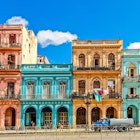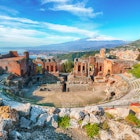
Jan 1, 2026 • 5 min read
Tuscany is the Italy many people dream about, but when is the best time to come? Find out with our guide to the best times for a Tuscan escape.

Jan 1, 2026 • 5 min read
Tuscany is the Italy many people dream about, but when is the best time to come? Find out with our guide to the best times for a Tuscan escape.

Jan 1, 2026 • 11 min read
Our editor discovered that a cultural sightseeing trip in Tuscany with two young children wasn't quite the vacation he expected.

Jan 1, 2026 • 7 min read
Here’s everything you need to know about New York City's Grand Slam tennis tournament.

Dec 31, 2025 • 3 min read
Get ready for a trip to Kenya with this list of pre-departure essential tips, from books to read to knowing what to pack.

Dec 30, 2025 • 10 min read
Here's everything you need to know to plan your time in Perth, Western Australia's remote and laid-back capital.

Dec 30, 2025 • 4 min read
Cuba offers a tropical escape year-round, with cultural festivals, live music and gorgeous beaches. Here's how to pick the best time for your trip.

Dec 29, 2025 • 6 min read
Sicily astounds with its abundance of architecture, hiking and food. Here are our favorite things to do during your next vacation.

Dec 29, 2025 • 6 min read
Plan your travels – by bike or car – along Burgundy's famous Route des Grands Crus, a road linking vineyards in France's famed wine region.

Dec 28, 2025 • 7 min read
Corfu has everything Greek dreams are made of: turquoise waters, abundant sunshine and delicious local cuisine.

Dec 28, 2025 • 5 min read
The Caribbean has many beautiful beaches, but Curaçao's pairings of white sand and blue water aren't to be missed. Here are the best.

Dec 27, 2025 • 8 min read
With its snowcapped mountains, charm-oozing towns and thousands of miles of coastline, Mexico is a popular travel destination. Here's where to go.

Dec 27, 2025 • 9 min read
From cocktail-tasting workshops to ATV tours and more, these exciting activities will show you the best of Curaçao’s peerless cultural blend.

Dec 26, 2025 • 6 min read
Gorilla trekking in Uganda's national parks brings you eye to eye with mountain gorillas, an endangered great ape species.

Dec 26, 2025 • 7 min read
Finding the bargains amid Key West's quaint, touristed streets can be tough. Still, a visit to this wonderful place doesn't have to light your budget on fire.

Dec 26, 2025 • 8 min read
Fabulous beaches, storied cities, rural retreats and Europe’s largest volcano: Sicily has it all. Here’s where to go (and stay) on this storied island.

Dec 25, 2025 • 6 min read
Like the mythical Sirens tempting sailors, Greece lures travelers to its scintillating shores. Dream up an ideal Greece itinerary to these 10 locales.

Dec 25, 2025 • 4 min read
Belize is where Latin-flavored Central America meets the captivating culture of the Caribbean. Here's how you can choose the perfect time to visit.

Dec 25, 2025 • 8 min read
Before you set off for dreamy Greece, read our tips to help you with planning your trip, and navigating the country once you arrive.

Dec 24, 2025 • 7 min read
Known for its natural beauty, specialty ramen and outdoor adventures, Hokkaidō is a relaxed, laid-back and totally captivating Japanese destination.

Dec 24, 2025 • 10 min read
From Paris to Provence, make the most of your time exploring France's many delights with our pick of the top places to see.

Dec 23, 2025 • 7 min read
Beyond the obvious towns of Lisbon and Porto, Portugal promises vibrant historic cities, incredible beaches and wonderful wine regions.

Dec 23, 2025 • 8 min read
Two Lonely Planet writers go head-to-head, debating which Spanish island is better: Mallorca or Ibiza.